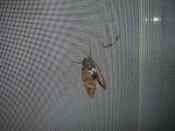This superb pair standing statue remains semi-attached to the limestone block from which they were carved. There is chipping on the surface of Memi's (man) right arm. A portion of Sabu's (woman) nose and her lips appear to be chipped off as well. On the lower part of Sabu's body there is chipping on both legs and right underneath her pelvic area. There are visible horizontal lines that cut right across Memi's right forearm and underneath Sabu's breasts. These lines may indicate what pieces of the statue had to be mended back together. There is also chipping on the bottom right hand corner of the stone slab underneath Memi's right leg. There are remnants of black paint on Sabu's wig, hairline and on her pupils. On Memi's left shoulder there is a small remnant of rust color paint that was probably the skin color used for his whole body.
Black paint is also visible on the lower portion of Memi's hair, especially along the tips closest to his shoulders. All other paint on the statue seems to have deteriorated over the years.
The hieroglyphs along the bottom of the stone slab label this work of historical art with representations of birds and plants. The representation of nature in Egyptian artwork is very common during the Old Kingdom time period. The overall statue remains fairly intact suffering from only one major handicap, which is the loss of its original color.
This pair statue subtly deviates from the conventional representations of husband and wife in Old Kingdom artwork. This statue is rather exceptional because we see an image where the wife's symbolic gesture that signifies their marital status is affectionately returned by her husband's embrace. There is a sense of intimacy and warmth in this embrace. This may...


